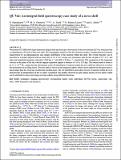Por favor, use este identificador para citar o enlazar a este item:
http://hdl.handle.net/10261/295743COMPARTIR / EXPORTAR:
 SHARE SHARE
 CORE
BASE CORE
BASE
|
|
| Visualizar otros formatos: MARC | Dublin Core | RDF | ORE | MODS | METS | DIDL | DATACITE | |

| Título: | QU Vul: An integral field spectroscopy case study of a nova shell |
Autor: | Santamaría, E.; Guerrero, Martín A. CSIC ORCID; Toalá, J. A.; Ramos-Larios, G.; Sabin, L. | Palabras clave: | Techniques: imaging spectroscopy Circumstellar matter Stars: individual: QU Vul Novae, cataclysmic variables ISM: kinematics and dynamics |
Fecha de publicación: | dic-2022 | Editor: | Oxford University Press | Citación: | Monthly Notices of the Royal Astronomical Society 517(2): 2567-2576 (2022) | Resumen: | We present GTC MEGARA high-dispersion integral field spectroscopic observations of the nova remnant QU Vul, which provide a comprehensive 3D view of this nova shell. The tomographic analysis of the H α emission reveals a complex physical structure characterized by an inhomogeneous and clumpy distribution of the material within this shell. The overall structure can be described as a prolate ellipsoid with an axial ratio of 1.4 ± 0.2, a major axis inclination with the line of sight of 12° ± 6°, and polar and equatorial expansion velocities ≈560 km s−1 and 400 ± 60 km s−1, respectively. The comparison of the expansion velocity on the plane of the sky with the angular expansion implies a distance of 1.43 ± 0.23 kpc. The ionized mass is found to be ≈2 × 10−4 M⊙, noting that the information on the 3D distribution of material within the nova shell has allowed us to reduce the uncertainty on its filling factor. The nova shell is still in its free expansion phase, which can be expected as the ejecta mass is much larger than the swept-up circumstellar medium mass. The 3D distribution and radial velocity of material within the nova shell provide an interpretation of the so-called ‘castellated’ line profiles observed in early optical spectra of nova shells, which can be attributed to knots and clumps moving radially along different directions. © 2022 The Author(s) Published by Oxford University Press on behalf of Royal Astronomical Society. | Versión del editor: | http://dx.doi.org/10.1093/mnras/stac2789 | URI: | http://hdl.handle.net/10261/295743 | DOI: | 10.1093/mnras/stac2789 | ISSN: | 0035-8711 | E-ISSN: | 1365-2966 |
| Aparece en las colecciones: | (IAA) Artículos |
Ficheros en este ítem:
| Fichero | Descripción | Tamaño | Formato | |
|---|---|---|---|---|
| 2022MNRAS.517.2567S.pdf | 1,6 MB | Adobe PDF |  Visualizar/Abrir |
CORE Recommender
SCOPUSTM
Citations
2
checked on 20-abr-2024
WEB OF SCIENCETM
Citations
2
checked on 27-feb-2024
Page view(s)
17
checked on 29-abr-2024
Download(s)
37
checked on 29-abr-2024
Google ScholarTM
Check
Altmetric
Altmetric
NOTA: Los ítems de Digital.CSIC están protegidos por copyright, con todos los derechos reservados, a menos que se indique lo contrario.
